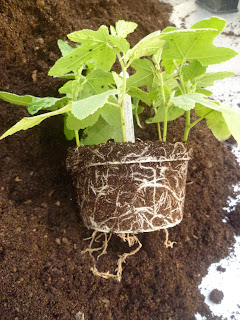 |
| Temporary fleece skirt |
Following a gloriously hot summer and the unseasonably high temperatures of this autumn, the forecast for Oxford tonight is below freezing, minus two! All the tender plants that hate the cold weather were moved into the greenhouse a month ago, see blog entry 18th October
'The Tender Giants Go Inside For The Winter', apart from the large clump of
Musa basjoo, the Japanese Banana, which are too big to move.
 |
| Wrapping the banana plants |
Removing the temporary fleece skirt that had been used to protect the stems over the last few weeks as the temperatures began to drop, the stems were wrapped individually and in small groups of two-three. The leaves were pulled down around the stems and tied to create the first layer of protection then wrapped in a double thickness horticultural fleece for the second protective layer.
 |
| 'Pups' |
At the base of the stems are the next generation of stems, the small
'Pups', that will grow up next year to create an even better display. However, one stem will not return as it has flowered and, now that it has produced a flower and fruit, it will die (monocarpic). The decision was made to leave this flower uncovered so it can be viewed and enjoyed for a little bit longer. This is the fourth time a flower has been produced from the stems of this clump of banana plants, the first time was in September 2010, the second, October 2014 and the third, July 2016.
 |
| Banana flower |
 |
| Inedible fruit |
When all the stems had been wrapped, a thick layer of leaf mould was added around the base to protect the root balls from frost. Looking like
'Pillars of Salt', these plants will remain under cover until late May next year when then temperatures have risen and they can safely unwrapped.
 |
| Wrapped and mulched for the winter |



















































